As an Amazon Associate I earn from qualifying purchases.
There are a multitude of ways to cook salmon with rice, but when I leave out the preposition and call it salmon rice, then you’ll know I am cooking Japanese. This recipe is clean, spare, easy to make, and so satisfying.
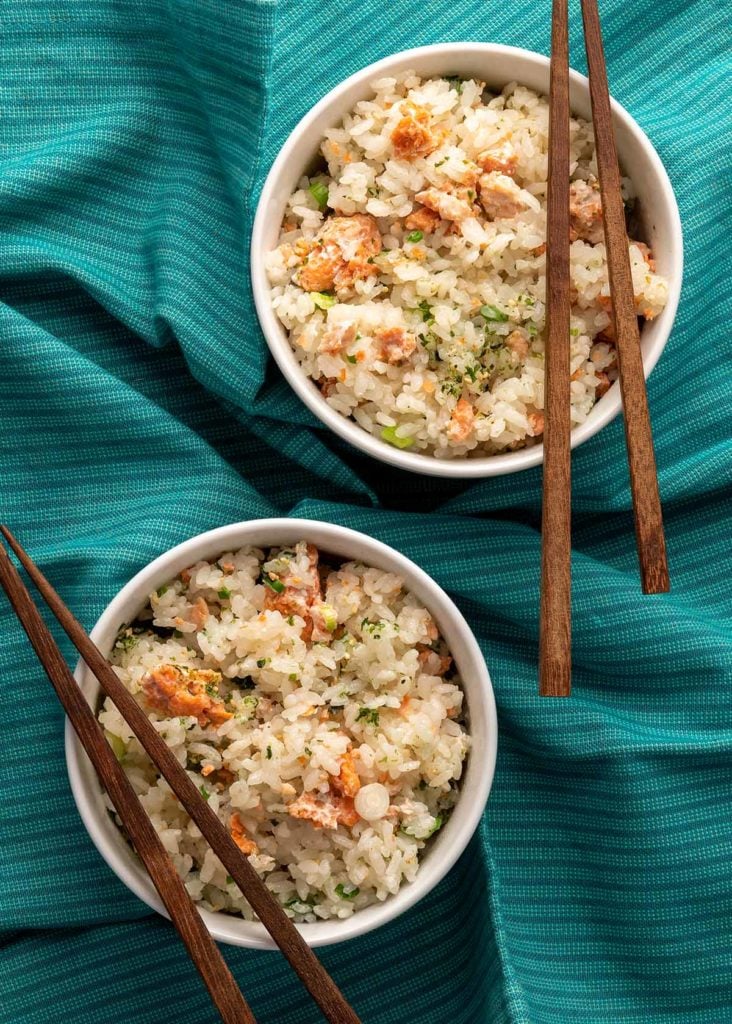
Just as there are lots of ways to put salmon in rice, there are a few ways to make this particular recipe. I’ll walk you through how I prefer it, and then give you some easier substitutions.
Also keep in mind that this recipe is excellent with trout, too. Or char.
I like to make salmon rice after salmon fishing, and while this might sound obvious, there is a reason: Because Japanese salmon rice relies on scraps, tidbits from the fish, rather than lush fillets or bellies.
You can of course use salmon fillets if that’s all you have, and you could use canned salmon in a pinch, but the best way to make salmon rice is by making your own salmon stock; I have a recipe for salmon stock elsewhere on this site.
And by making the stock, you get to pick off bits of meat from the carcasses, using that as the meat in the salmon rice.
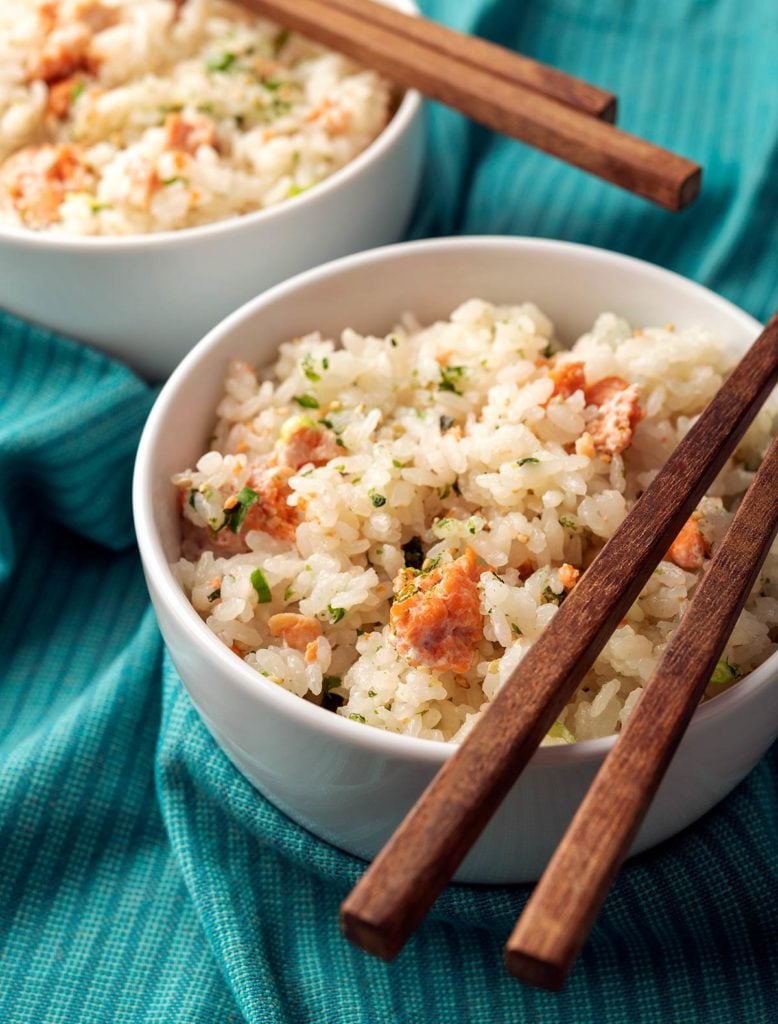
Doing it this way makes your salmon rice very salmon-y, in a good way if everything is fresh. You can make the stock up to four days beforehand, if you keep it in the fridge.
Don’t do this with stinky salmon. If you are buying salmon to make this, look for whole fish with crystalline, bright eyes, chrome-bright skin and gills that are crimson or rose pink. Have the fish filleted, use the fillets for another recipe, and save the carcass for salmon rice.
(You can browse dozens of my other salmon and trout recipes here.)
If buying a whole salmon isn’t an option, your next best bet is to make dashi. That requires a decent “Asian” aisle in your supermarket, or a trip to an Asian market, but it’s a really great alternative to salmon stock (This is a good, basic recipe for dashi.)
Barring both of those, use plain water. It’ll be fine.
The rice in salmon rice is important. You need Japanese rice to make it correctly. That means short-grain or medium-grain rice. It is very common in larger supermarkets, and the absolute best is called tamanishiki, which you can buy online.
Do not use risotto rice. If you can’t find Japanese rice (or of course Japanese varieties grown in California), use regular ole’ supermarket rice. Not basmati, not jasmine. Just standard American long-grain.
I cook my salmon rice with both salmon stock and a little sake. No need for any fancy sake here, just get a big bottle and use it to cook with. Or skip it.
Finally, there are two Japanese seasoning blends that will work very well with salmon rice: togarashi or furikake. Both are blends of things that make rice taste better, like sesame seeds, chile flakes, seaweed bits, etc. If your supermarket has any Japanese products at all in the “Asian” aisle, it’ll be there.
If not, toast 2 tablespoons or so of sesame seeds and use that.
So are you can see, if you have the raw materials on hand — most of which are pantry items — salmon rice is super easy to make and comes together in less than 30 minutes.
Looking for other great Japanese salmon recipes? I have a fantastic salmon miso soup, as well as a Japanese style salmon head soup.
Japanese Salmon Rice
Ingredients
- 1 1/2 cups Japanese rice
- 1/2 cup sake (optional)
- 1 3/4 cup salmon stock or dashi (or water)
- 2 green onions, sliced thin
- 1/3 pound cooked salmon meat, flaked
- 2 tablespoons furikake seasoning (see below)
- 1 to 2 tablespoons sesame oil
Instructions
- Follow the directions on the package for the exact amounts of water to cook your rice in. These directions are for nishiki rice, the most common Japanese rice in America. First, put your rice in a bowl and cover with water. Swish around until the water is cloudy. Pour this off; I water my plants withit. Do this a total of 3 times, until the water is mostly clear. Drain the rice in a strainer while you chop the green onions and flake the salmon.
- Put the rice, sake and stock in a pot, cover and turn on high until it boils. Drop the heat to medium-low and cook until the rice is mostly done, about 10 to 15 minutes. When it's done, quickly uncover the pot and put in the green onions and salmon. Cover the pot and wait 5 minutes.
- When you are ready to serve, fluff the rice with the sesame oil and furikake seasoning.
Notes
Keys to Success
- Follow the directions on the package in terms of how much water, stock, dashi etc. to use. Each variety of rice is a little different.
- Don’t skip the rinsing step or the rice will get all gluggy.
- The best salmon for salmon rice is meat picked off the carcass after making salmon stock. But you can quickly poach some salmon fillets, or use any leftover salmon here.
- The sesame oil isn’t strictly necessary, but I like it a lot, especially considering that this recipe has basically no other fat.
- Got leftover salmon rice? Mix it with an egg the next day, roll into patties, dust in rice flour, or regular flour, and fry. Delicious!
Nutrition
Nutrition information is automatically calculated, so should only be used as an approximation.


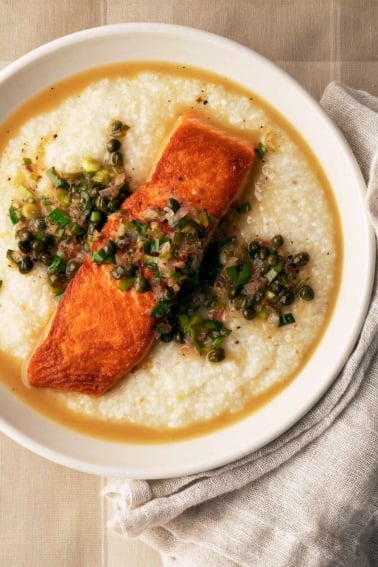
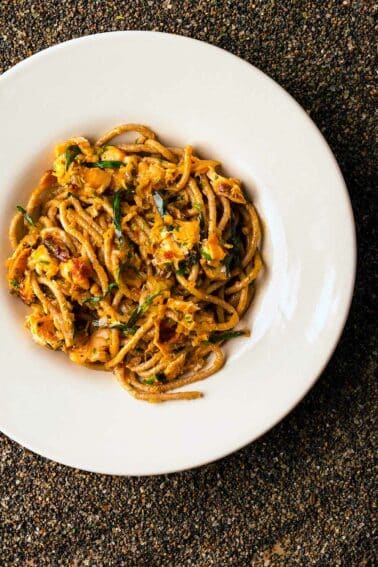
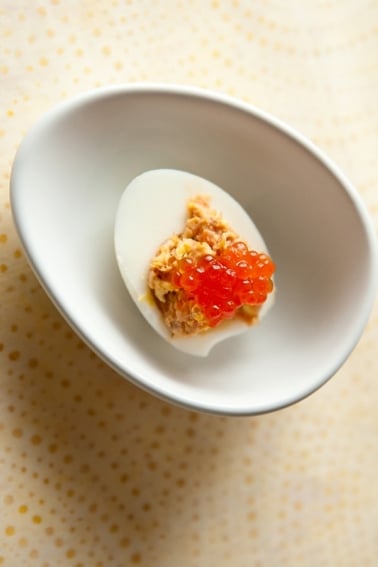
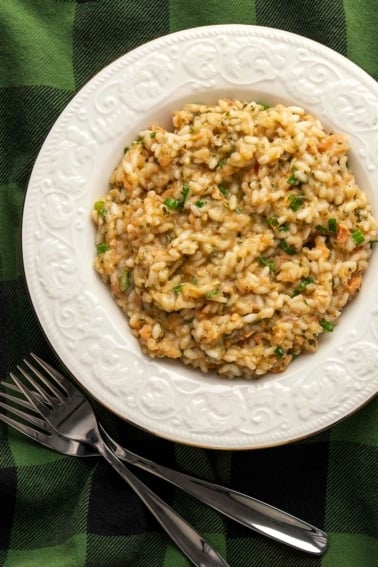
Thank you for the recipe. I made it for my wife and I and we both lived it. there are some ingredients which are difficult to find but I did. great and extremely easy. I have pic but no idea how to upload.
Thanks for the inspiration on this one, Hank! Not having access to whole salmon to make broth, I stumbled upon boxed Ramen broth at my local Kroger store. I used this broth to cook the rice in. I also came upon Kroger branded seaweed snacks (small sheets of dried seaweed) and went from there. After cooking the rice in the broth, I added crumbled salmon from a cooked filet, green onion, crumbled seaweed, and toasted sesame seeds. I finished by adding a drizzle of sesame oil and soy sauce at serving. What would I do differently next time? Small dice raw salmon, the addition of ginger in some form, and ponzu instead of regular soy sauce. This is one of those dishes that reminds me of Chili: Countless ways to do it, and very difficult to screw up. Delicious!
Simple and satisfying. A great use of my leftover baked salmon, and makes excellent fried salmon rice patties for breakfast!
Made this recipe and the salmon stock recipe as well for cooking the rice.
For the rice recipe, I had some steelhead bits, scraped off the spine with a spoon already from the previous week. The sushi rice I used, has to rest for 10 minutes off heat, which is when I added my raw steelhead and green onions and quickly put the lid back on. The residual heat is sufficient to cook the steelhead.
The great thing about the recipe is that you can gussy it up and still remain on point with the theme with items such as; slivered snow peas, diced avocado, thinly sliced radish, enoki mushrooms etc…
Could I make your salmon stock with whole, gutted kokanee and flake their meat for this dish, or would the cooking time for the salmon stock not be sufficient enough to cook whole kokes?
(Sorry for the repeat question, I accidentally asked this question on your stock recipe instead of here on the salmon rice recipe)
Jonathan: Absolutely. That would be a great idea!
I have made this before you posting recipe and agree it is really tasty and nutritious. I add some wilted spinach as vegetable component. I also use some smoked salmon flakes! Sesame oil gives it a nice lift!